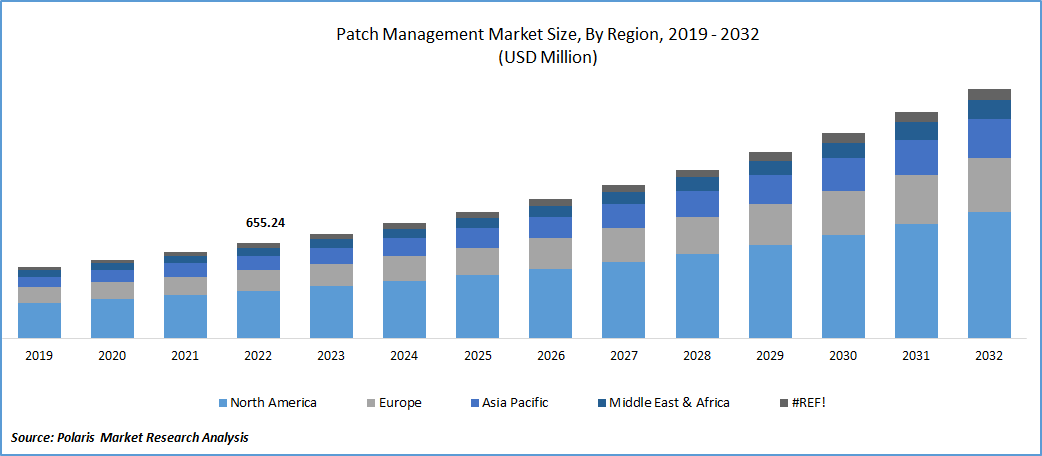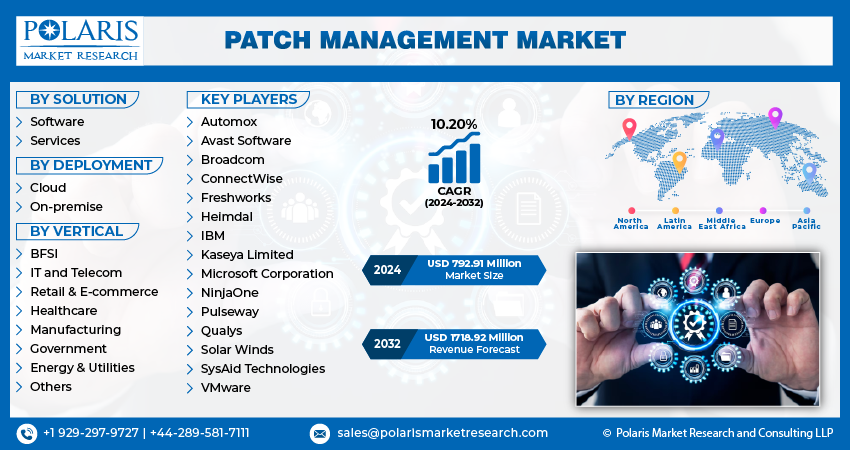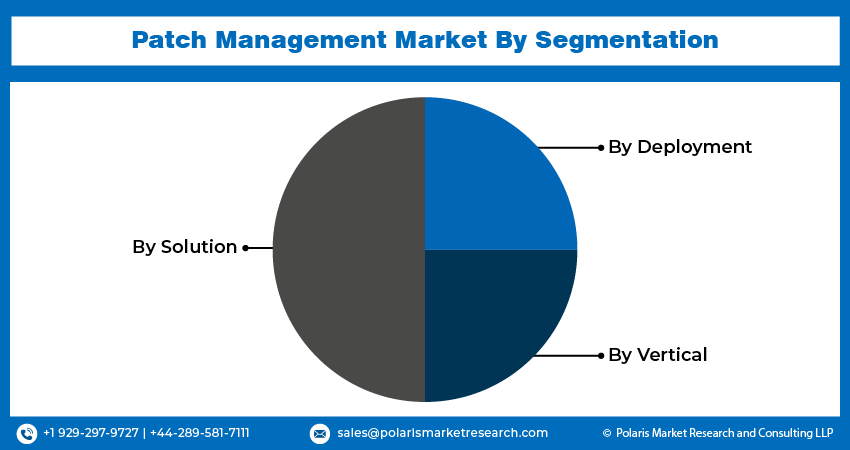
Patch Management Market Share, Size, Trends, Industry Analysis Report
By Solution (Software, Services); By Deployment; By Enterprise Size (Small & Medium-sized Enterprises, Large Enterprises); By Vertical; By Region, And Segment Forecasts, 2024 - 2032
- Published Date:Jan-2024
- Pages: 112
- Format: PDF
- Report ID: PM3651
- Base Year: 2023
- Historical Data: 2019-2022
Report Outlook
The global patch management market was valued at USD 720.69 million in 2022 and is expected to grow at a CAGR of 10.20% during the forecast period.
Growth is primarily driven by the rising adoption of third-party applications, the growing emphasis on software security, increased user awareness about cybersecurity, and the growing demand for DevSecOps (Development, Security, and Operations). Businesses are increasingly relying on various DevOps software and tools, such as TrendMicro Cloud One, ScriptRunner, & NinjaOne, to enable seamless collaboration between their development and operations teams. These solutions automate key processes such as software development, testing, deployment, and operations, thereby contributing to the overall market expansion.

To Understand More About this Research: Request a Free Sample Report
Having comprehensive visibility and control over the network infrastructure is crucial for IT and security teams to effectively manage the process. Standardizing and automating the transfer and deployment of programs throughout their lifecycle in a delivery pipeline is essential, presenting a significant opportunity for patch management solution providers. With the increase in remote working, the risk of data breaches and cyber-attacks has also escalated. This poses a major challenge for data security, as devices can be lost, stolen, or compromised. Patch management solutions offer a potential solution by incorporating security features such as real-time behavioral analysis of events and historical tracking of memory, disks, and devices. These solutions play a vital role in mitigating these concerns and safeguarding critical corporate data.
Industry Dynamics
Growth Drivers
The increase in vulnerabilities to promote patch management solution and growing deployment of third-party applications drives the market growth.
Patch management plays a crucial role in automating the correlation of vulnerabilities with patches and associated configuration changes, resulting in reduced response time for remediation. It efficiently maps vulnerabilities to fixes and generates ready-to-deploy tasks that can be automatically delivered and scheduled. These factors contribute to the growth of the patch management industry in the forecast period. Security holds paramount importance in today's complex Internet of Things (IoT) ecosystem. The rapid expansion of interconnected devices generates vast amounts of data, which enables the development of new business models like Products-as-a-Service (PaaS) and real-time automated decision-making. However, the proliferation of the IoT ecosystem also introduces new attack vectors, providing hackers with opportunities for data and identity theft, intellectual property (IP) theft, data manipulation, device manipulation, and network manipulation.
In response to these risks, cybersecurity companies and service providers are actively developing security solutions that enable organizations to automate their IT security processes. These systems offer automated threat detection, reducing the time and effort required to track malicious activities. They provide real-time monitoring and swift identification of emerging threats, with the capability to respond autonomously. These factors contribute to the patch management market's growth potential in the forecast period.
- In June 2023, NinjaOne, a security service provider, announced the expansion of its NinjaOne patch management solutions. These solutions offer automated patching capabilities and services to ensure the continuous operation and security of organizations by addressing vulnerabilities.
The technology streamlines the entire patch management process, enabling companies to efficiently identify and remediate vulnerabilities while minimizing security risks through automation. Despite the complexity associated with endpoint detection and response patch management, concerted efforts are being made to enhance the accessibility and manageability of these solutions for organizations of all sizes.

Report Segmentation
The market is primarily segmented based on solution, deployment, enterprise size, vertical, and region.
|
By Solution |
By Deployment |
By Vertical |
By Region |
|
|
|
|
To Understand the Scope of this Report: Speak to Analyst
By Solution Analysis
Software segment accounted for the largest market share in 2022
Software segment accounted for largest of global market share. Numerous organizations are actively embracing patch management solutions that possess advanced capabilities for detecting vulnerabilities that could potentially lead to cyberattacks. These solutions provide a vulnerability management framework that assists organizations in evaluating, addressing, and identifying vulnerabilities present in their software and systems. By implementing effective security strategies, organizations can mitigate potential threats and reduce their attack surface.
Service segment is likely to grow at fastest growth rate over the next coming years. It encompasses a wide range of offerings, providing expert & personalized guidance to clients in identifying risks, & ensuring the secure protection of end-point devices against the future threats. These companies also assess the IT infrastructure of the enterprises and provide recommendations on adopting patch management systems, whether on-premises or in the cloud.
By Deployment Analysis
Cloud based segment held the significant market revenue share in 2022
Cloud based segment held the majority market share in terms of revenue. Despite the advancements in cloud computing, cloud-based platforms still face risks associated with cybercrime and data breaches. To address these concerns, cloud patch management solutions utilize cloud-powered tools to effectively manage and apply patches, including operating system (OS) updates, third-party patches, and software updates, to endpoints. Unlike traditional endpoint management solutions that often require hardware installations at each location, cloud patch management solutions offer the advantage of centralized management and deployment, eliminating the need for extensive versioning maintenance as patch management vendors continuously release new features and bug fixes. This allows organizations to maintain their endpoints efficiently and securely in the cloud environment.
On premise segment is likely to exhibit fastest growth rate. On-premise patch management solutions are preferred by enterprises to automatically patch internal servers and devices located within their own infrastructure. Large enterprises opt for on-premise solutions as they desire complete ownership and control over the patching process and system upgrades. However, as the workforce expands and the transition to remote work becomes more prevalent, IT professionals relying on on-premise patching tools often face challenges in effectively and efficiently securing endpoints. This is primarily due to the limited visibility into software assets and the difficulties in monitoring and patching remote devices, which can result in vulnerabilities and potential security risks.
By Vertical Analysis
Healthcare segment witnessed steady growth over the projection period
Healthcare segment witnessed steady growth rate over the study period. This growth can be attributed to the increasing utilization of cloud-based solutions, as well as the widespread adoption of connected devices and smartphones. The healthcare industry has witnessed a surge in the integration of Internet of Things (IoT)-enabled medical devices, Electronic Health Records (EHRs), and other advanced healthcare technologies, leading to a highly interconnected healthcare ecosystem.

Regional Analysis
North America region dominated the global market in 2022
The North America region dominated the global market. Region’s growth is attributed to demand for robust cyber security measures, including the adoption of security and vulnerability assessment tools. Additionally, the region is home to major IT hubs, leading to a higher adoption of patch management solutions by organizations seeking to enhance their cyber security posture. Furthermore, the preference for cloud-based patch management solutions has gained traction among SMEs in the region. These solutions offer benefits such as improved business efficiency, cost-effectiveness, and flexibility, driving their adoption in the region. The United States is expected to hold the largest market share due to the high adoption rate of patch management solutions and services, as well as the presence of key patch management providers in the country.
The Asia Pacific region is expected to be the fastest growing region. The region's growth can be attributed to several factors. Firstly, the Bring Your Own Device (BYOD) movement has gained significant momentum in the region, leading to an increased need for effective patch management solutions to ensure the security of data on personal devices used for work purposes. Moreover, governments in the region have taken proactive measures to support cybersecurity compliances and protect against data breaches. This has further fueled the demand for patch management solutions as organizations strive to safeguard their sensitive data from potential attacks.

Competitive Insight
The market is fragmented and is anticipated to witness competition due to several players' presence. Major service providers in the market are constantly upgrading their technologies to stay ahead of the competition and to ensure efficiency, integrity, and safety. These players focus on partnership, product upgrades, and collaboration to gain a competitive edge over their peers and capture a significant market share.
Some of the major players operating in the global market include:
- Automox
- Avast Software
- Broadcom
- ConnectWise
- Freshworks
- Heimdal
- IBM
- Kaseya Limited
- Microsoft Corporation
- NinjaOne
- Pulseway
- Qualys
- Solar Winds
- SysAid Technologies
- VMware
Recent Developments
- In January 2023, Action 1 Corporation, a provider of patch management solutions, introduced a complimentary cloud-native tool for IT teams, enabling them to detect and address risks proactively.
- In May 2022, New Relic, a vulnerability, and security management firm headquartered in the United States, unveiled its latest offering, the New Relic Vulnerability Management platform. This platform empowers enterprises to efficiently and accurately identify and resolve security risks in a timely manner.
Patch Management Market Report Scope
|
Report Attributes |
Details |
|
Market size value in 2024 |
USD 792.91 million |
|
Revenue forecast in 2032 |
USD 1718.92 million |
|
CAGR |
10.20% from 2024 – 2032 |
|
Base year |
2023 |
|
Historical data |
2019 – 2022 |
|
Forecast period |
2024 – 2032 |
|
Quantitative units |
Revenue in USD million/billion and CAGR from 2024 to 2032 |
|
Segments covered |
By Solution, By Deployment, By Enterprise Size, By Vertical, By Region |
|
Regional scope |
North America, Europe, Asia Pacific, Latin America; Middle East & Africa |
|
Key companies |
Microsoft Corporation, Broadcom, Qualys, Solar Winds, ConnectWise, IBM, VMware, Avast Software, Automox, Freshworks, NinjaOne, Pulseway, Kaseya Limited, Heimdal, & SysAid. |
FAQ's
The Patch Management Market report covering key are solution, deployment, enterprise size, vertical, and region.
Patch Management Market Size Worth $ 1,718.92 Million By 2032.
The global patch management market is expected to grow at a CAGR of 10.1% during the forecast period.
North America is Patch Management Market.
key driving factors in Patch Management Market are Growing preference for cloud patch management solutions.
